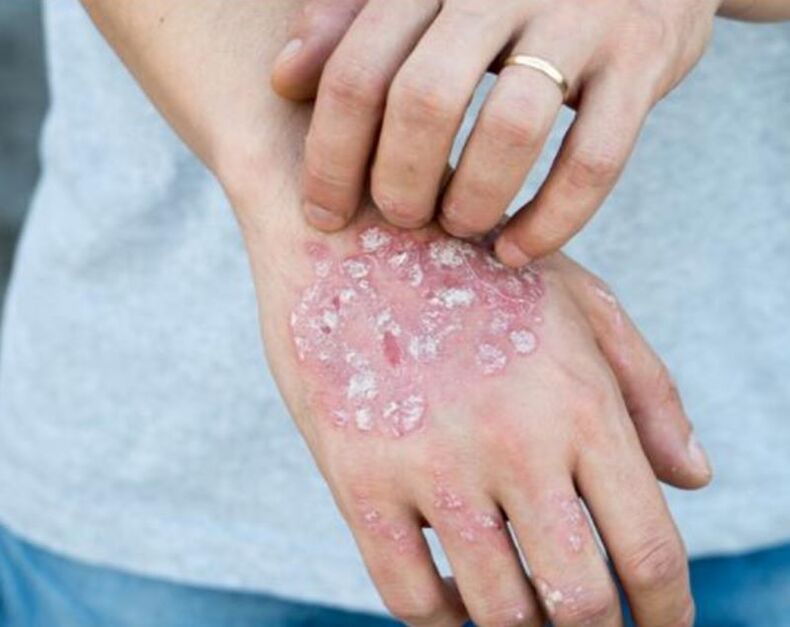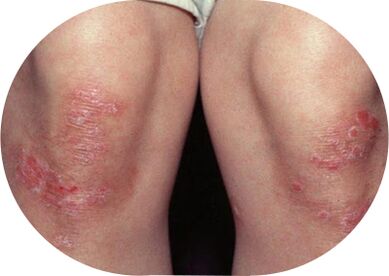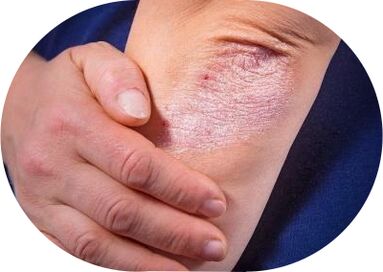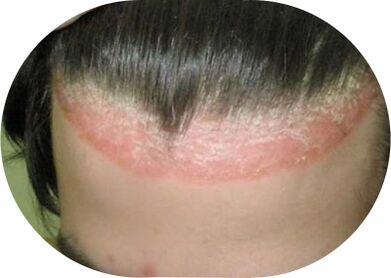Psoriasis is one of the most common skin diseases, one in every hundred inhabitants suffers from it.
Psoriasis is a disease for whose development several factors are important at the same time: from hereditary predisposition (psoriasis in relatives) to disorders in the functioning of the nervous, endocrine, immune and other factors.

The reasons
The causes of psoriasis are not fully understood.
The principle of the disease mechanism is to disrupt the division of skin cells, which provokes an autoimmune reaction (autoimmune reaction: occurs inside the body, does not depend on external threats).
The top layer of the skin (epidermis) is made up mainly of keratinocytes, cells that produce keratin. Keratin is a protein, its properties allow it to carry out the protective function of the skin. Keratinocytes are formed in the deep layers of the epidermis and slowly move towards its surface, during movement they mature and acquire new properties.
At the end of their "maturation", keratinocytes form a stratum corneum on the surface of the skin. The keratinized cells then die and exfoliate from the living ones, so the life path of keratinocytes comes to an end. This ensures a continuous renewal of the skin.
The normal path of keratinocytes from the deep layer to the surface takes one month. With psoriasis, its lifespan is reduced to several days, this leads to the appearance of scaly psoriatic foci, since the skin does not have time to get rid of keratinized cells.
When they appear, psoriatic plaques are often accompanied by itching and redness. This indicates an autoimmune reaction in the deep layers of the skin, resulting in swelling of the thick layer of the skin (dermis). The dermis contains blood and lymphatic vessels.
It is not sure why the keratinocyte formation process is accelerated, but a hereditary factor is known to play an important role.
The development of common psoriasis can begin due to:
- mental trauma and constant stressful conditions;
- damage to the skin;
- transferred infectious disease;
- taking some medications;
- hormonal disorders;
- allergic reactions (typical allergens: citrus, eggs, chocolate);
- Alcohol intoxication;
- climate change.
The psoriatic triad is a characteristic symptom of the disease that occurs when the skin is scraped.
Stearin stain(increased desquamation after scraping, making the surface of the papules look like a crushed drop of stearin).
Thermal film(the appearance after complete removal of the scales from a wet, thin, shiny, translucent surface).
Point bleeding(the appearance of drops of blood that do not merge with each other).
What happens to the skin in psoriasis?
In psoriasis, the structure of the skin is altered, the epidermis becomes thinner, the processes of keratinization of the skin (accumulation of the protein keratin) are interrupted and some layers of the normal epidermis disappear. In the next stage of the disease, groups of cells responsible for inflammation are found in the superficial protective stratum corneum of the epidermis and in the area of parakeratosis, around the dilated vessels of the skin.
Characteristic plaques and scales appear on the surface of the skin.
Psoriasis is not just a common disease, it has many manifestations and even masquerades as other diseases.

Psoriasis localization sites:
- elbows and knees;
- sacrum and loin;
- scalp (seborrheic psoriasis);
- flexion surfaces and skin folds: the inner surface of the elbow and knee joints, groin and armpits, the area under the breast (inverse psoriasis);
- palms and surfaces of the feet (palmar-plantar psoriasis);
- nail plate psoriasis.
Common symptoms of psoriasis
The main symptoms of psoriasis are:
- psoriatic plaques;
- tightness of the affected skin area;
- Itch.
Symptoms by type of psoriasis:
- exudative psoriasis (affected areas of the skin peel off and become wet, a yellow crust forms on the surface of the rash);
- intertriginous psoriasis (more common in children, the foci of appearance are red, with slight scaling, sometimes wet ones can be confused with diaper rash);
- old psoriasis (characterized by large plaques that do not disappear for a long time);
- Rupioid psoriasis (another form of chronic psoriasis, characterized by a cone-shaped plaque);
- guttate psoriasis (profuse eruption of small papules).
Types of psoriasis
- Ordinary psoriasis (vulgar, plaque);
- Generalized psoriasis (generalized, postulate);
- Teardrop psoriasis (depending on the type of rash);
- Arthropathic psoriasis (with joint damage);
- Other types of psoriasis (seborrheic and others).
Vulgar psoriasis is the most common form of the disease.
Psoriasis begins with the appearance of rashes, often few, in typical places: on the elbows and knees. In addition, the characteristic location of the rash is the area of the scalp and trunk. Usually there is a clear connection between the appearance of rashes and the action of the provoking factor.
Triggers for psoriasis can include stress, skin trauma, a recent infectious disease, and regular alcohol use.
Usually the exacerbation of the disease occurs in the cold season; This is the winter type of psoriasis. The summer type is rarer. Now mixed forms of psoriasis are seen. Over time, the number of rashes increases. They form characteristic psoriatic plaques. Kebner phenomenon is observed: the appearance of new plaques in places of skin trauma. As a general rule, patients have plaques that remain on the skin even without exacerbations.
The disease flows cyclically:
- Progressive stage (an increase in the number of rashes);
- Stationary stage (no new eruptions appear);
- Regressive stage (regression of rashes, appearance in their place of areas of skin without pigment).
Psoriasis vulgaris, photo



Diagnostics
When diagnosing psoriasis, first of all, a detailed examination of the skin is required.
Thin skin, bleeding in places, loose plaques are signs of psoriasis. In the presence of these symptoms, the doctor performs a series of diagnostic measures to exclude the presence of other events with similar manifestations. For the final diagnosis, blood tests, smears, and skin biopsies are performed as needed. If the joints are affected, an MRI is prescribed and X-rays are taken to identify the lesions.
Psoriasis vulgaris, treatment
Psoriasis is a systemic disease with skin manifestations, and complex treatment is needed: both local and systemic therapy. The disease is chronic and treatment is aimed at reducing the number and severity of exacerbations and achieving a skin condition that is acceptable to the patient.
In the progressive stage of psoriasis all aggressive procedures are canceled: ultraviolet irradiation, baths. . . It is important that psoriasis patients handle the skin carefully and carefully, not hurt it, to avoid exacerbations and the appearance of new plaques.
Diet for psoriasis
Psoriasis is often accompanied by liver disease, so it is important to avoid alcohol, fatty, fried, and smoked foods. It is equally important to be moderate in carbohydrate intake, as this changes the pH of the skin and increases the risk of infection of the rash.
Prophylaxis
Preventing psoriasis is about maintaining a healthy lifestyle. This helps prevent the onset of other diseases, as the body's immune system is protected from stress and can resist threats from the outside.
Psoriasis prevention measures include:
- proper skin care;
- relaxing massage to improve blood circulation;
- proper nutrition, it is advisable to avoid allergenic foods and exclude (limit) the intake of spicy, fatty, pickled, smoked, salty foods, as well as citrus fruits;
- dairy-vegetable diet;
- a sufficient amount of moisture in the body;
- elimination of alcohol and smoking and other bad habits;
- Increased physical activity;
- walk in the open air;
- avoid stressful situations;
- taking vitamins of groups A, B, C, D, E;
- choosing loose clothing made of natural materials that does not rub or cause irritation.
Means for the treatment of psoriasis.
Systemic therapy for psoriasis aims to reduce the proliferation of the skin epithelium, stabilizing the keratinization of skin cells and cell membranes. For this, preparations based on vitamin A (retinoids), cytostatics are used. Of the most modern treatments, the so-called biological ones are used, which neutralize substances that cause inflammation.
For many years, UFOs have been used: treatment with group B ultraviolet rays (in tanning beds, group A rays), which reduce inflammation and contribute to the death of altered cells. PUVA therapy is the simultaneous use of ultraviolet radiation and a special substance that increases the sensitivity of the skin to it.
An effective remedy for psoriasis.
Local treatment is no less important than systemic treatment. Helps reduce skin inflammation. Medications are prescribed depending on the stage of psoriasis.
Progressive stage
- exfoliating ointments and lotions;
- hormonal anti-inflammatory ointments with calcitriol;
- emollients to relieve itching and dry skin.
Stationary stage
- UVB therapy;
- concentrated exfoliating ointments;
- emollients to restore skin and reduce dryness.
Regressive stage
- concentrated exfoliating ointments;
- emollients to restore skin and reduce dryness.
Psoriasis cream
Creams and ointments for psoriasis have different purposes and are used at different stages of the disease, while hormonal anti-inflammatory creams and ointments are used to stop inflammatory processes in the skin. There are several classes of hormonal drugs. They have different absorption capacities and different activities. When used in children, they try to avoid applying hormonal drugs to the area of the face and neck, the area of skin folds, places where the skin is thinner. Local preparations based on calcipotriol (a derivative of vitamin D) also have an anti-inflammatory effect. This is a later generation of drugs. They are not currently used during pregnancy and lactation.
Salicylic ointment and salicylic acid lotion are designed to remove flakes from severely scaly skin. Salicylic acid not only has an exfoliating effect, but also increases the effectiveness of local hormonal drugs. In the stationary and regressive stage, when the inflammation has become less active, salicylic acid-based agents are used in a higher concentration.
Means to restore the structure of the skin and eliminate dryness are used throughout the treatment period, as well as in conjunction with ultraviolet irradiation to reduce itching of the skin. Once breakouts have subsided, these products help maintain the skin's protective properties and reduce the risk of new breakouts.
An effective cream for psoriasis
The modern approach to the care and assistance of dry skin is based on saturating the epidermis with moisture and is called corneotherapy (derived from "corneum" - corneal or corneal layer of the epidermis).
Corneotherapy aims to restore the stratum corneum of the epidermis and its protective functions, which makes it possible to improve the condition of the skin as a whole. The works of the founder of corneotherapy, Albert Kligman, made it possible to create special means - emollients.
How do emollients work?
1 hour after the application of the emollients: - improves the condition of the skin, because the emollients "retain" moisture.
6 hours after the application of emollients: - the skin structure is restored due to the content of special restorative natural lipids (ceramides and other useful fats).
24 hours after the application of emollients: - there is a clinical improvement in the condition of the skin due to the penetration of moisturizing components into the deep layers of the epidermis and the restoration of the superficial layers of the skin (up to 24 hours from theapplication startup).























